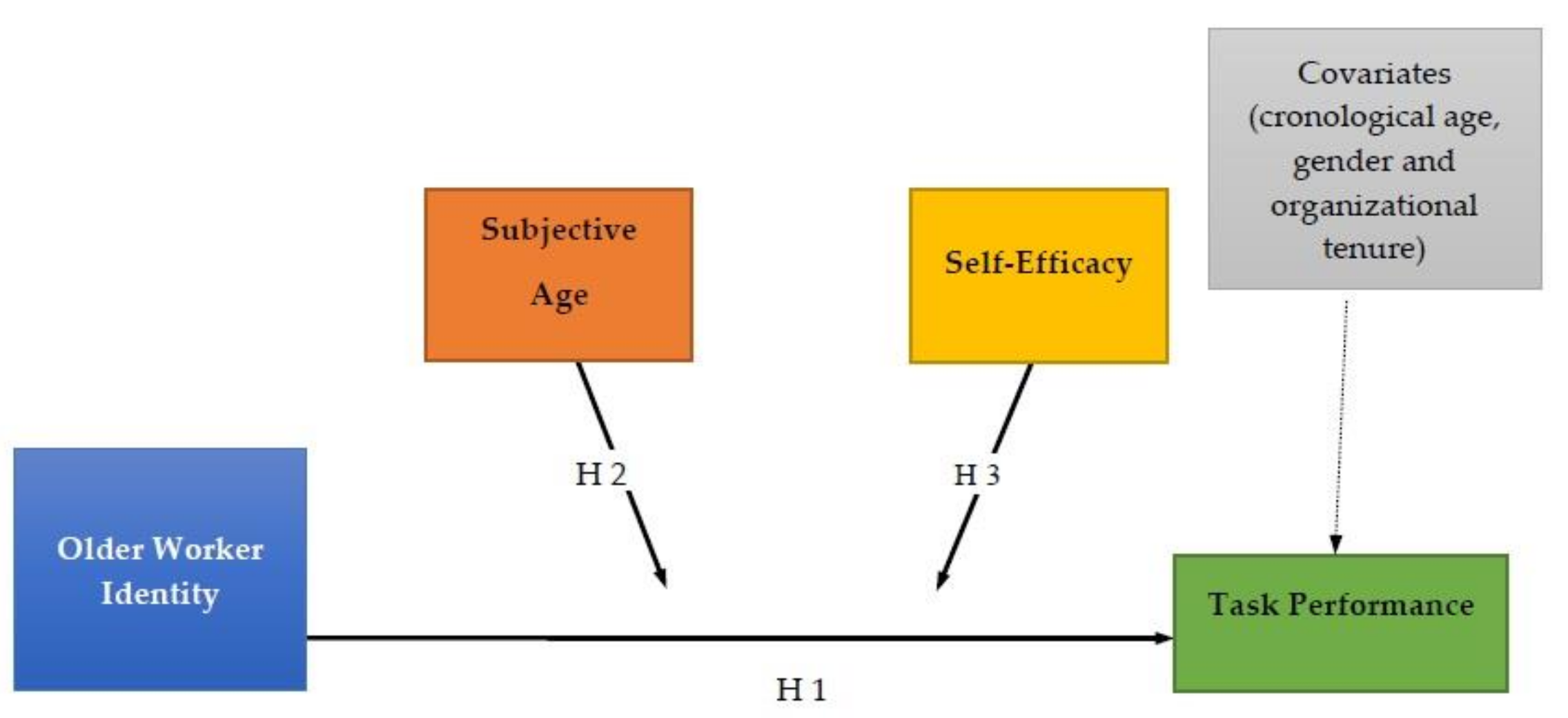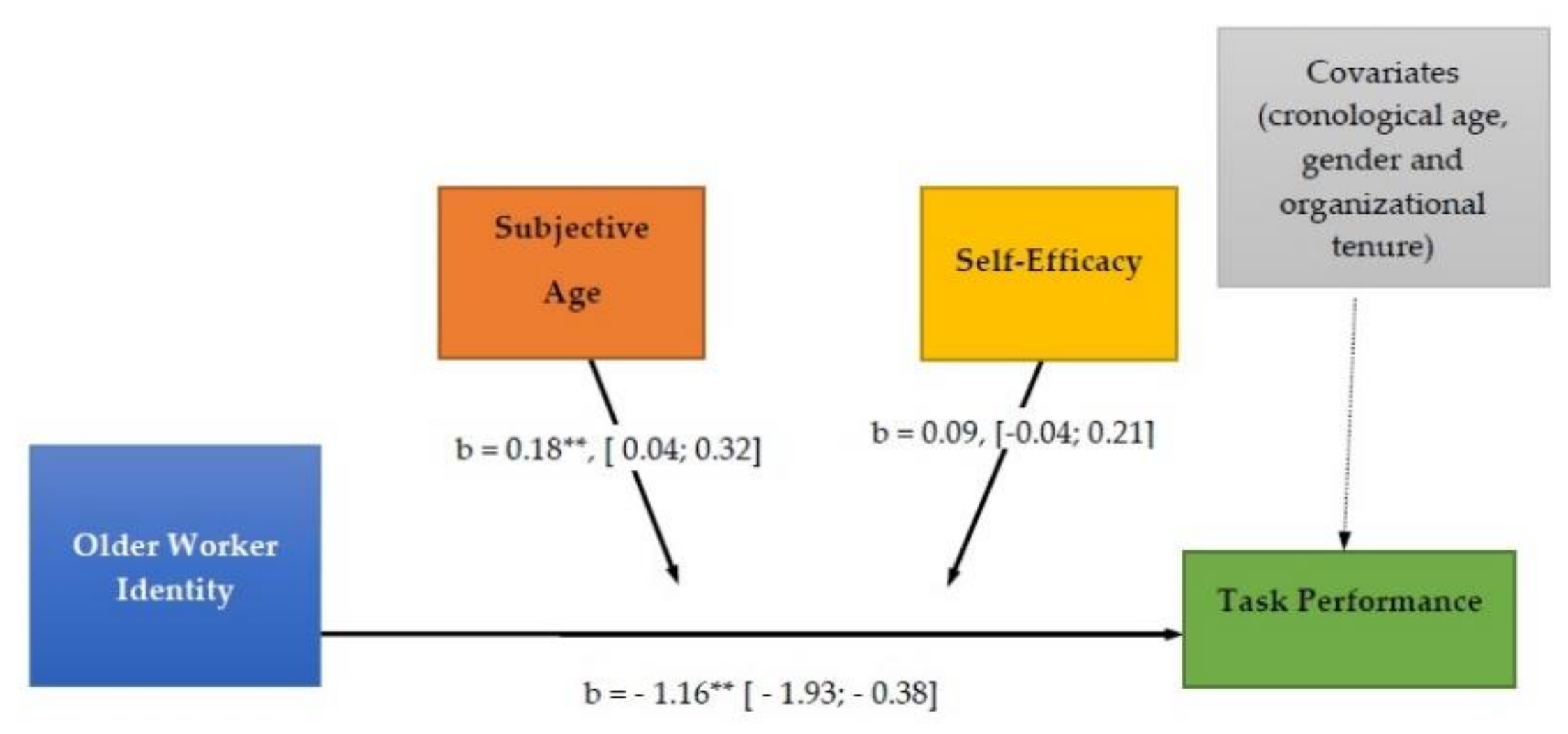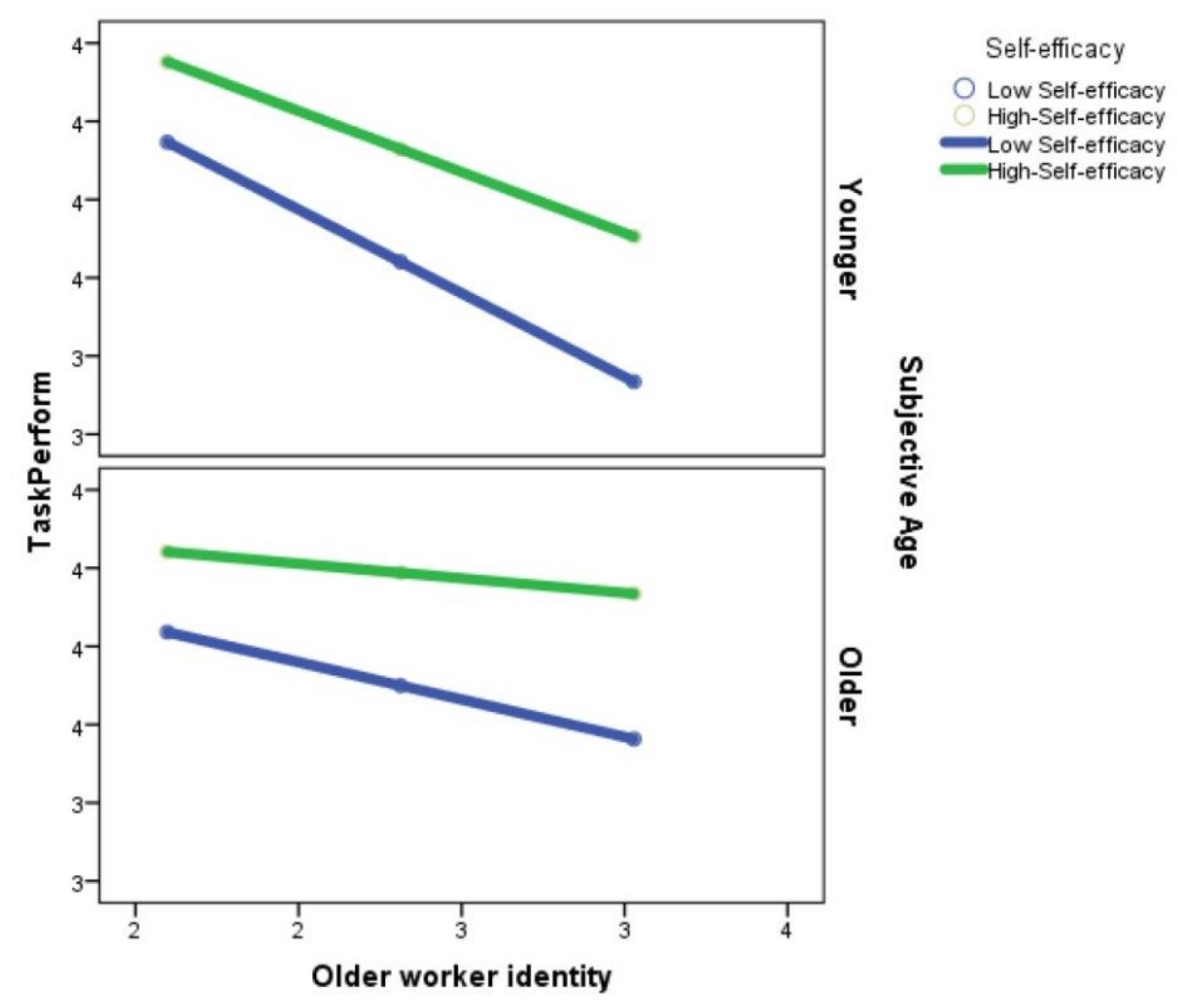Older Worker Identity and Job Performance: The Moderator Role of Subjective Age and Self-Efficacy
Abstract
1. Introduction
1.1. Older Worker Identity and Task Performance
1.2. The Moderator Role of Subjective Age and Self-Efficacy
2. Materials and Methods
2.1. Ethical Information
2.2. Participants
2.3. Procedure
2.4. Instruments
2.4.1. Older Worker Identity
2.4.2. Subjective Age
2.4.3. Self-Efficacy
2.4.4. Task Performance
2.5. Statistical Analyses
3. Results
Moderation Analysis
4. Discussion
4.1. Limitations of the Study
4.2. Suggestions for the Extension of Working Life
5. Conclusions
Author Contributions
Funding
Conflicts of Interest
References
- Collinson, C. Wishful Thinking or within Reach? 3 Generations Prepare for Retirement; Transamerica Center for Retirement Studies: Los Angeles, CA, USA, 2017. [Google Scholar]
- Quinn, J.F.; Cahill, K.E. Challenges and Opportunities of Living and Working Longer. In How Persistent Low Returns Will Shape Saving and Retirement; Mitchel, O., Clark, R., Maurer, R., Eds.; Oxford University Press: London, UK, 2018; pp. 101–119. ISBN 978-0-19-882744-3. [Google Scholar]
- Ng, T.W.H.; Feldman, D.C. Evaluating six common stereotypes about older workers with meta-analytical data. Pers. Psychol. 2012, 65, 821–858. [Google Scholar] [CrossRef]
- Ali Al-Atwi, A.; Bakir, A. Relationships between status judgments, identification, and counterproductive behavior. J. Manag. Psychol. 2014, 29, 472–489. [Google Scholar] [CrossRef]
- Chiesa, R.; Toderi, S.; Dordoni, P.; Henkens, K.; Fiabane, E.M.; Setti, I. Older workers: Stereotypes and occupational self-efficacy. J. Manag. Psychol. 2016, 31, 1152–1166. [Google Scholar] [CrossRef]
- Zacher, H.; Esser, L.; Bohlmann, C.; Rudolph, C.W. Age, Social Identity and Identification, and Work Outcomes: A Conceptual Model, Literature Review, and Future Research Directions. Work Aging Retire. 2018. [Google Scholar] [CrossRef]
- Kunze, F.; Raes, A.M.; Bruch, H. It matters how old you feel: Antecedents and performance consequences of average relative subjective age in organizations. J. Appl. Psychol. 2015, 100, 1511–1526. [Google Scholar] [CrossRef] [PubMed]
- Fournier, G., Zimmermann. Job loss in a group of older Canadian workers: Challenges in the sustainable labour market reintegration process. Sustainability 2018, 7, 2245. [Google Scholar] [CrossRef]
- Ruggs, E.N.; Michelle, R.; Hebl, S.; Walker, S.; Fa-Kaji, N. Selection biases that emerge when age meets gender. J. Manag. Psychol. 2014, 29, 1028–1043. [Google Scholar] [CrossRef]
- Di Marco, D.; Arenas, A.; Giorgi, G.; Arcangeli, G.; Mucci, N. Be Friendly, Stay Well: The Effects of Job Resources on Well-Being in a Discriminatory Work Environment. Front. Psychol. 2018, 9, 413. [Google Scholar] [CrossRef]
- Fisher, G.G.; Chaffee, D.S.; Tetrick, L.E.; Davalos, D.B.; Potter, G.G. Cognitive functioning, aging, and work: A review and recommendations for research and practice. J. Occup. Health Psychol. 2017, 22, 314–336. [Google Scholar] [CrossRef]
- Christ, O.; van Dick, R.; Wanger, U.; Stellmacher, J. When teachers go the extra mile: Foci of organisational identification as determinants of different forms of organisational citizenship behaviour among schoolteachers. Br. J. Educ. Psychol. 2003, 73, 329–341. [Google Scholar] [CrossRef]
- Lyons, B.J.; Wessel, L.; Chiew Tai, Y.; Ryan, M.A. Strategies of job seekers related to age-related stereotypes. J. Manag. Psychol. 2014, 29, 1009–1027. [Google Scholar] [CrossRef]
- Mudaly, P.; Nkosi, Z.Z. Factors influencing nurse absenteeism in a general hospital in D urban, South Africa. J. Nurs. Manag. 2015, 23, 623–631. [Google Scholar] [CrossRef] [PubMed]
- Zaniboni, S. The interaction between older workers’ personal resources and perceived age discrimination affects the desired retirement age and the expected adjustment. Work Aging Retire. 2015, 1, 266–273. [Google Scholar] [CrossRef]
- Topa, G.; Alcover, C.-M. Psychosocial factors in retirement intentions and adjustment: A multi-sample study. Career Dev. Int. 2015, 20, 384–408. [Google Scholar] [CrossRef]
- Garstka, T.A.; Schmitt, M.T.; Branscombe, N.R.; Hummert, M.L. How young and older adults differ in their responses to perceived age discrimination. Psychol. Aging 2004, 19, 326–335. [Google Scholar] [CrossRef] [PubMed]
- Redman, T.; Snape, E. The consequences of perceived age discrimination amongst older police officers: Is social support a buffer? Br. J. Manag. 2006, 17, 167–175. [Google Scholar] [CrossRef]
- Zaniboni, S.; Sarchielli, G.; Fraccaroli, F. How are psychosocial factors related to retirement intentions? Int. J. Manpow. 2010, 31, 271–285. [Google Scholar] [CrossRef]
- Snape, E.; Redman, T. Too old or too young? The impact of perceived age discrimination. Hum. Resource Manag. J. 2003, 13, 78–89. [Google Scholar] [CrossRef]
- Segura, A.; Topa, G. Identificación con los trabajadores mayores y absentismo: Moderación de la Selección, Optimización y Compensación [Older Worker Identity and absenteeism: Moderation of Selection, Optimization and Compensation]. Acción Psicol. 2016, 13, 169–189. [Google Scholar] [CrossRef]
- Koopmans, L.; Bernaards, C.M.; Hildebrandt, V.H.; Schaufeli, W.B.; de Vet, H.C.W.; van der Beek, A.J. Conceptual Frameworks of Individual Work Performance: A Systematic Review. J. Occup. Environ. Med. 2011, 53, 856–866. [Google Scholar] [CrossRef]
- Lallemand, T.; Rycx, F. Are Young and Old Workers Harmful for Firm Productivity? De Economist 2009, 157, 273–292. [Google Scholar] [CrossRef]
- Van Dalen, H.; Henkens, K.; Schippers, J. Productivity of Older Workers: Perceptions of Employers and Employees. Popul. Dev. Rev. 2010, 36, 309–330. [Google Scholar] [CrossRef] [PubMed]
- Schwarze, M.; Egen, C.; Gutenbrunner, C.; Schriek, S. Early Workplace Intervention to Improve the Work Ability of Employees with Musculoskeletal Disorders in a German University Hospital—Results of a Pilot Study. Healthcare 2016, 4, 64. [Google Scholar] [CrossRef] [PubMed]
- Johns, G.; Al Hajj, R. Frequency versus time lost measures of absenteeism: Is the voluntariness distinction an urban legend? J. Organ. Behav. 2016, 2016. 37, 456–479. [Google Scholar] [CrossRef]
- Barak, B. Cognitive age: A new multidimensional approach to measuring age identity. Int. J. Aging Hum. Dev. 1987, 1987. 25, 109–128. [Google Scholar] [CrossRef]
- Shore, L.M.; Cleveland, J.N.; Goldberg, C.B. Work attitudes and decisions as a function of manager age and employee age. J. Appl. Psychol. 2003, 88, 529–537. [Google Scholar] [CrossRef]
- Truxillo, D.M.; Zaniboni, S. Work design and aging. In Encyclopedia of Geropsychology; Springer: Singapore, Singapore, 2015; pp. 1–9. [Google Scholar]
- Kunze, F.; Boehm, S.A.; Bruch, H. Age diversity, age discrimination climate and performance consequences—A cross organizational study. J. Organ. Behav. 2011, 32, 264–290. [Google Scholar] [CrossRef]
- Goecke, T.; Kunze, F. The contextual role of subjective age in the chronological age/absenteeism relationship in blue and white-collar teams. Eur. J. Work Organ. Psychol. 2018, 27, 1–15. [Google Scholar]
- Kooij, D.T.A.M.; de Lange, A.H.; Jansen, P.G.W.; Kanfer, R.; Dikkers, J.S.E. Age and work-related motives: Results of a meta-analysis. J. Organ. Behav. 2011, 32, 197–225. [Google Scholar] [CrossRef]
- Kooij, D.T.A.M.; Bal, P.M.; Kanfer, R. Future time perspective and promotion focus as determinants of intraindividual change in work motivation. Psychol. Aging 2014, 29, 319–328. [Google Scholar] [CrossRef]
- Robertson, D.A.; Weiss, D. In the eye of the beholder: Can counter-stereotypes change perceptions of older adults’ social status? Psychol. Aging 2017, 32, 531–542. [Google Scholar] [CrossRef] [PubMed]
- Bandura, A. Self-efficacy: Toward a unifying theory of behavioral change. Psychol. Rev. 1977, 84, 191–215. [Google Scholar] [CrossRef] [PubMed]
- Stajkovic, A.; Luthans, F. Self-efficacy and work-related performance: A meta-analysis. Psychol. Bull. 1998, 124, 240–261. [Google Scholar] [CrossRef]
- Kim, B.-J.; Kim, T.-H.; Jung, S.-Y. How to Enhance Sustainability through Transformational Leadership: The Important Role of Employees’ Forgiveness. Sustainability 2018, 10, 2682. [Google Scholar] [CrossRef]
- Zhang, Y.; Zheng, J.; Darko, A. How Does Transformational Leadership Promote Innovation in Construction? The Mediating Role of Innovation Climate and the Multilevel Moderation Role of Project Requirements. Sustainability 2018, 10, 1506. [Google Scholar] [CrossRef]
- Chiesa, R.; Fazi, L.; Guglielmi, D.; Mariani, M.G. Enhancing Substainability: Psychological Capital, Perceived Employability, and Job Insecurity in Different Work Contract Conditions. Sustainability 2018, 10, 2475. [Google Scholar] [CrossRef]
- Luthans, F.; Avolio, B.; Avey, J.B.; Norman, S. Positive Psychological Capital: Measurement and Relationship with Performance and Satisfaction. Pers. Psychol. 2007, 60, 541–572. [Google Scholar] [CrossRef]
- Luthans, F.; Avey, J.B.; Avolio, B.; Norman, S.; Combs, G. Psychological Capital Development: Toward a Micro-Intervention. J. Organ. Behav. 2006, 27, 387–393. [Google Scholar] [CrossRef]
- Luthans, F.; Avey, J.B.; Patera, J.L. Experimental analysis of a Web-based intervention to develop positive psychological capital. Acad. Manag. Learn. Educ. 2008, 7, 209–221. [Google Scholar] [CrossRef]
- Etikariena, A. The effect of psychological capital as a mediator variable on the relationship between work happiness and innovative work behavior. In Diversity in Unity: Perspectives from Psychology and Behavioral Sciences; Ariyanto, A.A., Muluk, H., Newcombe, P., Piercy, F.P., Poerwandari, E.K., Suradijono, S.R., Eds.; Routledge/Taylor and Francis Group: New York, NY, USA, 2018. [Google Scholar]
- Huang, L.; Luthans, F. Toward better understanding of the learning goal orientation–creativity relationship: The role of positive psychological capital. Appl. Psychol. Int. Rev. 2015, 64, 444–472. [Google Scholar] [CrossRef]
- Karatepe, O.M.; Avci, T. The effects of psychological capital and work engagement on nurses’ lateness attitude and turnover intentions. J. Manag. Dev. 2017, 36, 1029–1039. [Google Scholar] [CrossRef]
- Youssef-Morgan, C.M.; Luthans, F. Psychological capital and well-being. Stress Health 2015, 31, 180–188. [Google Scholar] [CrossRef] [PubMed]
- Nafei, W. Meta-Analysis of the Impact of Psychological Capital on Quality of Work Life and Organizational Citizenship Behavior: A Study on Sadat City University. Int. J. Bus. Admin. 2015, 6, 42–59. [Google Scholar] [CrossRef]
- Tougas, F.; Lagacé, M.; de la Sablonnière, R.; Kocum, L. A new approach to the link between identity and relative deprivation in the perspective of ageism and retirement. Int. J. Aging Hum. Dev. 2004, 59, 1–23. [Google Scholar] [CrossRef] [PubMed]
- León-pérez, José, M.; Antino, M.; León-Rubio, J.M. Adaptation of the short version of the Psychological Capital Questionnaire (PCQ-12) into Spanish/Adaptación al español de la versión reducida del Cuestionario de Capital Psicológico (PCQ-12). J. Soc. Psychol. 2017, 32, 196–213. [Google Scholar] [CrossRef]
- Luthans, F.; Youssef, C.; Avolio, B.J. Psychological Capital: Developing the Human Competitive Edge; Oxford University Press: Oxford, UK, 2007. [Google Scholar]
- Koopmans, L.; Bernaards, C.M.; Hildebrandt, V.H.; van Buuren, S.; van de Beek, A.J.; de Vet, H.C.W. Improving the Individual Work Performance Questionnaire using Rasch analysis. J. Appl. Meas. 2014, 15, 160–175. [Google Scholar] [CrossRef] [PubMed]
- Hayes, A.F. Introduction to Mediation, Moderation, and Conditional Process Analysis: A Regression-Based Approach; The Guilford Press: New York, NY, USA, 2013. [Google Scholar]
- Müller, A.; Weigl, M. SOC Strategies and Organizational Citizenship Behaviors toward the Benefits of Co-workers: A Multi-Source Study. Front. Psychol. 2017, 8, 1740. [Google Scholar] [CrossRef] [PubMed]
- Bouwhuis, S.; De Wind, A.; De Kruif, A.; Geuskens, G.A.; Van der Beek, A.J.; Bongers, P.M.; Boot, C.R.L. Experiences with multiple job holding: A qualitative study among Dutch older workers. BMC Public Health 2018, 18, 1054. [Google Scholar] [CrossRef]
- Fernández-Salinero, S.; Topa, G. Motivational orientations and organizational citizenship behaviors: Moderator role of perceived discrimination in the Brexit context. Presented at the Second International Conference “Healthier Societies Fostering Healthy Organizations: A Cross-Cultural Perspective”, University of Florence, Florence, Italy, 30–31 August–1 18. University of Florence, Florence, Italy, 30 August–1 September 2018. [Google Scholar]
- Alola, U.V.; Avci, T.; Ozturen, A. Organization Sustainability through Human Resource Capital: The Impacts of Supervisor Incivility and Self-Efficacy. Sustainability 2018, 10, 2610. [Google Scholar] [CrossRef]
- Hermans, J.; Slabbinck, H.; Vanderstraeten, J.; Brassey, J.; Dejardin, M.; Ramdani, D.; van Witteloostuijn, A. The Power Paradox: Implicit and Explicit Power Motives, and the Importance Attached to Prosocial Organizational Goals in SMEs. Sustainability 2017, 9, 2001. [Google Scholar] [CrossRef]
- Zacher, H.; Rudolph, C.W. Just a mirage: On the incremental predictive validity of subjective age. Work Aging Retire. 2018. [Google Scholar] [CrossRef]
- Salanova, M.; Llorens, S.; Schaufeli, W.B. “Yes, I can, I feel good, and I just do it!” On gain cycles and spirals of efficacy beliefs, affect and engagement. Appl. Psychol. Int. Rev. 2011, 60, 255–285. [Google Scholar] [CrossRef]
- Yoo, W.-J.; Choo, H.H.; Lee, S.J. A Study on the Sustainable Growth of SMEs: The Mediating Role of Organizational Metacognition. Sustainability 2018, 10, 2829. [Google Scholar] [CrossRef]
- Zaniboni, S.; Topa, G. The Role of Subjective and Chronological Age in Affecting the Retirement Planning and the Expected Adjustment. Paper Presented at the 13th Conference of EAOHP. Lisbon, Portugal, –7 September 2018. [Google Scholar]
- Bergomi, M.; Modenese, A.; Ferretti, E.; Ferrari, A.; Licitra, G.; Vivoli, R.; Gobba, F.; Aggazzotti, G. Work-related stress and role of personality in a sample of Italian bus drivers. Work 2017, 57, 433–440. [Google Scholar] [CrossRef]
- Jinnett, K.; Schwatka, N.; Tenney, L.; Brockbank, C.V.S.; Newman, L.S. Chronic conditions, workplace safety, and job demands contribute to absenteeism and job performance. Health Aff. 2017, 36, 237–244. [Google Scholar] [CrossRef] [PubMed]
- Azim, M.T.; Islam, M.M. Social Support, Religious Endorsement, and Career Commitment: A Study on Saudi Nurses. Behav. Sci. 2018, 8, 8. [Google Scholar] [CrossRef] [PubMed]
- Fournier, G.; Zimmermann, H.; Masdonati, J.; Gauthier, C. Job Loss in a Group of Older Canadian Workers: Challenges in the Sustainable Labour Market Reintegration Process. Sustainability 2018, 10, 2245. [Google Scholar] [CrossRef]



| Variables | M | SD | 1 | 2 | 3 | 4 | 5 | 6 | 7 |
|---|---|---|---|---|---|---|---|---|---|
| 1. Gender | 1.41 | 0.52 | n.a | ||||||
| 2. Chronologic Age | 48.11 | 6.93 | −0.09 | n.a | |||||
| 3. Organizational tenure | 16.25 | 11.13 | −0.12 | 0.53 ** | n.a | ||||
| 4. Older Worker Identity | 2.31 | 0.72 | −0.16 * | 0.10 | 0.15 * | 0.82 | |||
| 5. Self-efficacy | 3.94 | 0.67 | 0.02 | −0.06 | 0.06 | −0.16 * | 0.75 | ||
| 6. Subjective Age | 3.02 | 0.66 | −0.08 | 0.67 ** | 0.32 ** | 0.11 | −0.13 | 0.70 | |
| 7. Task performance | 3.82 | 0.48 | 0.07 | −0.5 | −0.3 | −0.42 ** | 0.34 ** | −0.1 | 0.70 |
| Subjective Age | Self-Efficacy | Effect of OWI on Task Performance | SE | t | p | LLCI | ULCI |
|---|---|---|---|---|---|---|---|
| 2.3694 | 3.2638 | −0.4334 | 0.0890 | −4.8673 | 0.0000 | −0.6091 | −0.2578 |
| 2.3694 | 3.9367 | −0.3736 | 0.0638 | −5.8561 | 0.0000 | −0.4994 | −0.2478 |
| 2.3694 | 4.6095 | −0.3137 | 0.0620 | −5.0635 | 0.0000 | −0.4360 | −0.1915 |
| 3.0250 | 3.2638 | −0.3122 | 0.0662 | −4.7162 | 0.0000 | −0.4427 | −0.1816 |
| 3.0250 | 3.9367 | −0.2523 | 0.0438 | −5.7612 | 0.0000 | −0.3387 | −0.1659 |
| 3.0250 | 4.6095 | −0.1925 | 0.0555 | −3.4660 | 0.0007 | −0.3021 | −0.0830 |
| 3.6806 | 3.2638 | −0.1909 | 0.0739 | −2.5853 | 0.0105 | −0.3366 | −0.0453 |
| 3.6806 | 3.9367 | −0.1311 | 0.0662 | −1.9791 | 0.0492 | −0.2618 | −0.0004 |
| 3.6806 | 4.6095 | −0.0713 | 0.0834 | −0.8548 | 0.3938 | −0.2357 | 0.0932 |
© 2018 by the authors. Licensee MDPI, Basel, Switzerland. This article is an open access article distributed under the terms and conditions of the Creative Commons Attribution (CC BY) license (http://creativecommons.org/licenses/by/4.0/).
Share and Cite
Rodríguez-Cifuentes, F.; Farfán, J.; Topa, G. Older Worker Identity and Job Performance: The Moderator Role of Subjective Age and Self-Efficacy. Int. J. Environ. Res. Public Health 2018, 15, 2731. https://doi.org/10.3390/ijerph15122731
Rodríguez-Cifuentes F, Farfán J, Topa G. Older Worker Identity and Job Performance: The Moderator Role of Subjective Age and Self-Efficacy. International Journal of Environmental Research and Public Health. 2018; 15(12):2731. https://doi.org/10.3390/ijerph15122731
Chicago/Turabian StyleRodríguez-Cifuentes, Francisco, Jesús Farfán, and Gabriela Topa. 2018. "Older Worker Identity and Job Performance: The Moderator Role of Subjective Age and Self-Efficacy" International Journal of Environmental Research and Public Health 15, no. 12: 2731. https://doi.org/10.3390/ijerph15122731
APA StyleRodríguez-Cifuentes, F., Farfán, J., & Topa, G. (2018). Older Worker Identity and Job Performance: The Moderator Role of Subjective Age and Self-Efficacy. International Journal of Environmental Research and Public Health, 15(12), 2731. https://doi.org/10.3390/ijerph15122731






